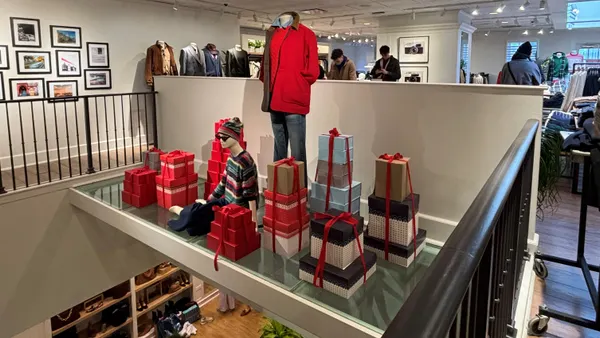Dive Brief:
- Macy's added 20 off-price locations in the first quarter as part of a plan to open 100 off-price outlets — dubbed Macy's Backstage — in fiscal 2018, the department store retailer said Monday in a press release.
- Macy's is also expanding the geographical footprint of Backstage, venturing into the northwestern and southwestern U.S. The new locations would open in existing Macy's stores, the company said.
- To support the growth, the company is adding a distribution center in Ohio dedicated to the off-price unit. The facility is scheduled to open in fall 2019 and would add 400 jobs to Macy's payrolls. CEO Jeff Gennette said the distribution center would "enable us to move merchandise to our Backstage locations faster and with more flexibility."
Dive Insight:
Macy's Backstage build-out this year is a significant expansion into the off-price business. It would nearly double the locations Macy's had going into the fiscal year, and the investment represents a sizable chunk of more than $1 billion planned capital expenditures, the company said in its latest 10-K. (The expansion of the beauty concept Bluemercury, acquired in 2015, is another major investment.)
To Macy's, Backstage represents not just an entry into a hot off-price sector — one that has been stealing significant market share from department stores and appears poised to do more of the same. It's also a chance for the retailer to make its stores more productive.
The prices, layouts and assortment at Backstage locations don't differ much from those at from other major off-price players, like T.J. Maxx, Ross and Burlington. Macy's lags behind those stalwarts, as well as behind fellow department store retailer Nordstrom, which has built a $4 billion off-price business with its Rack stores, first launched in 1973.
Nordstrom drew a distinct line between its traditional department stores and Rack stores, which are typically in stand-alone locations separate from its full-line stores. Meanwhile, Macy's is mainly building inside existing stores. Plenty of analysts and other observers have wondered if Macy's might cannibalize its own sales and customer base by doing so.
For its part, Macy's hopes to increase the productivity of its full-line stores by adding Backstage to them. Gennette told analysts in February that the company found in 2017 "a lift in performance of almost seven full points per store" that had a Backstage in it. "[A]nd we believe there is more upside," he added, according to a Seeking Alpha transcript of a conference call.
Backstage also presents a way to keep customers at Macy's department stores, and presents a potential alternative to closing unproductive stores (of which Macy's has closed more than 100 recently). Last year, Gennette said that two-thirds of Macy's "best customers" also shop at off-price stores on a monthly basis.
The new distribution center could help the company manage a separate stream of inventory — that includes different product categories, such as toys and children's shoes — going to Backstage. Michelle Israel, Macy's senior vice president of off-price, who was appointed as head of Backstage in 2017, told Retail Dive in a statement last year that the unit is separately sourced, with different buying teams.
To make Backstage work for customers and manage their expectations, Macy's has to differentiate its pricing and products at the outlets, Shelley E. Kohan, vice president of retail consulting with RetailNext, told Retail Dive in an interview last year. "You have to be really clear about differentiation," she said. "It could be in assortment, it could be in dollars, it could be in convenience."














